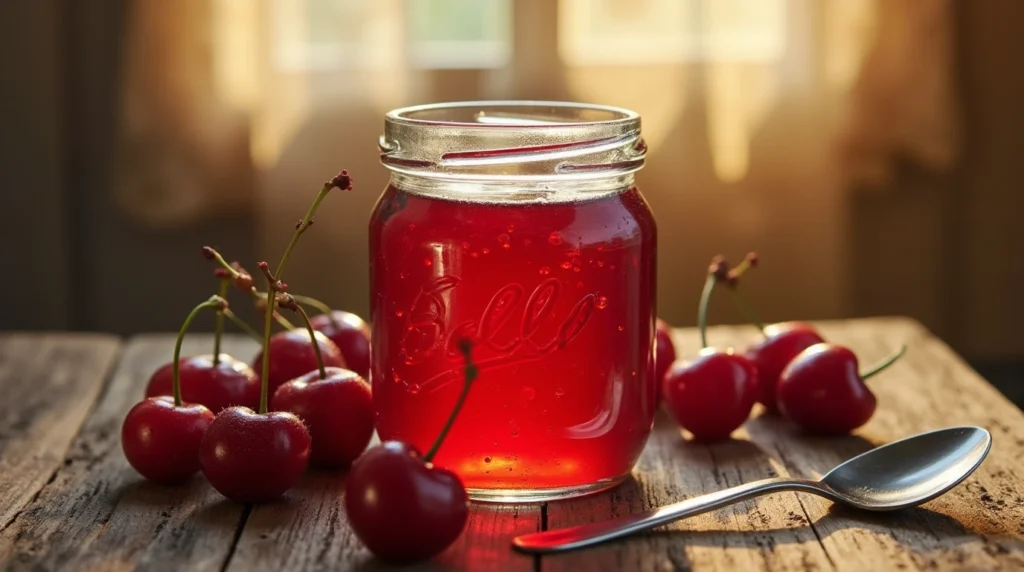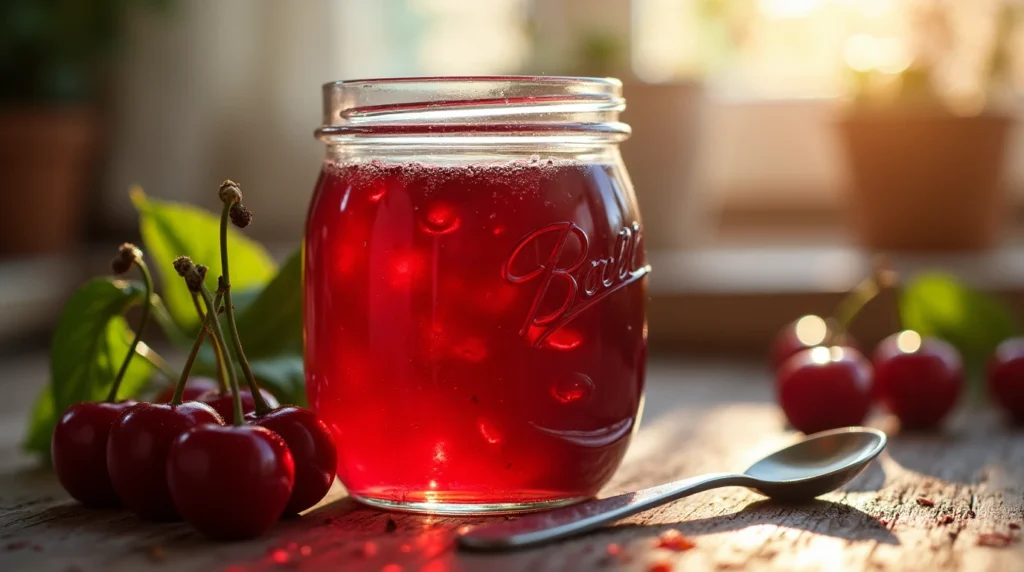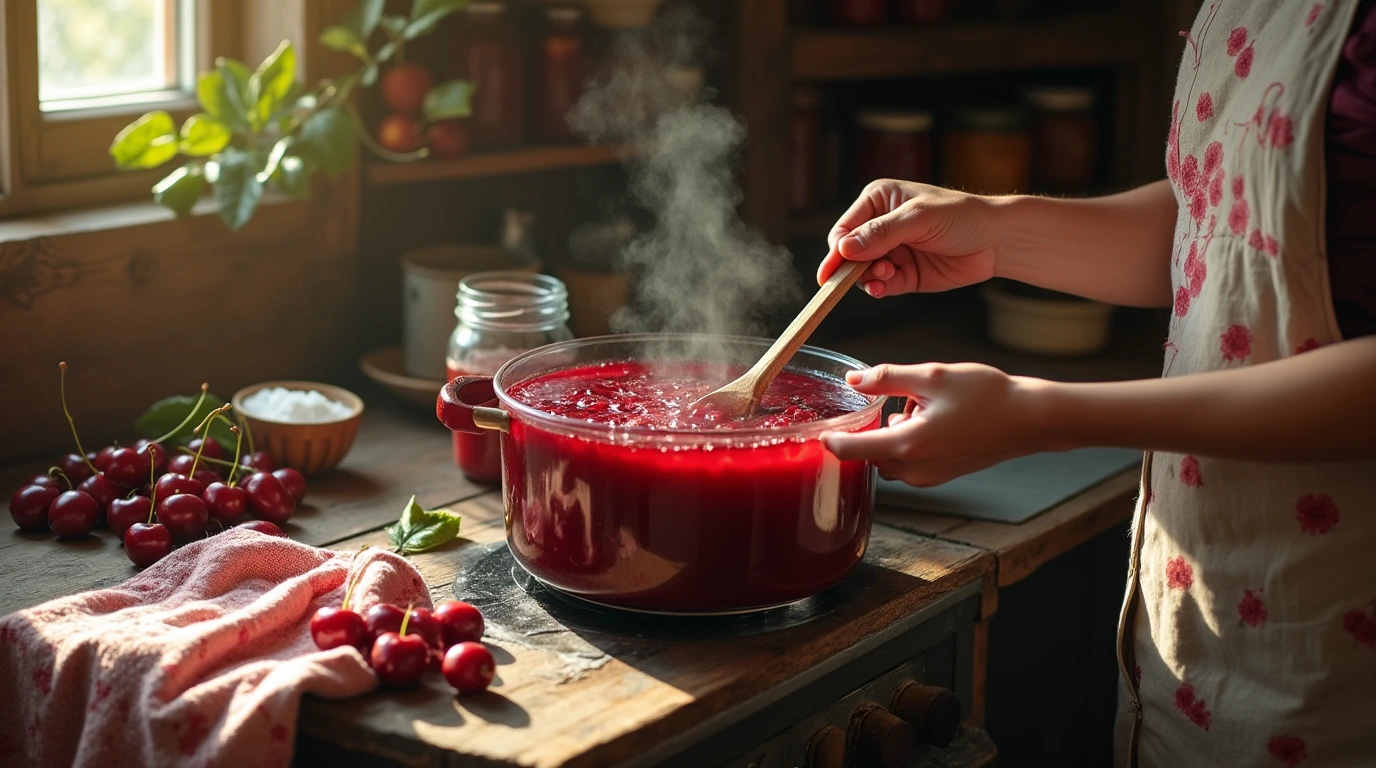Making the perfect cherry jelly is a fun challenge. But, how do you thicken cherry jelly to get the right texture? Finding the right balance between taste and texture is key. A great cherry jelly recipe not only tastes amazing but also looks great.
This section will teach you the basics of jelly-making. You’ll learn about the fruit-to-sugar ratio, boiling time, and the best techniques. Making three pounds of cherries into jelly can fill six 8-ounce mason jars. This is a great reason to get good at making jelly.
Key Takeaways
- Achieving the right consistency in cherry jelly is essential for flavor and appeal.
- Understanding the fruit-to-sugar ratio helps in effective jelly-making.
- A rolling boil of 15 minutes is ideal for stabilizing jelly texture.
- The right pectin and cooking techniques are crucial for thickening.
- Homemade cherry jelly can be preserved for up to one year when canned properly.
- Monitoring jelly temperature ensures successful consistency.
- Utilizing kitchen tools like cherry pitters simplifies the preparation process.
Understanding the Basics of Cherry Jelly
Starting to make cherry jelly means learning the basics. You need to pick the right cherries, like sweet and sour ones. These cherries have less pectin, so you must be careful.
The main ingredients are cherries, sugar, and sometimes lemon juice. This adds flavor and a bit of acidity. You want about 0.5 to 1.5 percent pectin in the mix for the right thickness. The sugar and fruit juice mix should be between 1:1 and 1:2.
Using cherries that are not yet ripe makes the jelly firmer. This is because they have more pectin. Stir the mix well and heat it to 221°F. This makes the jelly thick and perfect.

Knowing how to use cherry jelly ingredients is key. About 90% of home canning fails are due to bad techniques. This can mess up the jelly’s thickness and taste. Learning these basics makes your jelly better and keeps it fresh longer.
Common Challenges in Jelly Making
Making jelly can be fun, but it has its challenges. Getting the right texture is key. Jellies should be clear and hold their shape when removed from a container.
One big issue is runny jelly. This happens when the mix doesn’t set right. It’s often due to wrong ratios of pectin and sugar, or the fruit used.
Different fruits gel differently. Group I fruits, like sour apples, gel with just sugar. But Group II fruits, like ripe cherries, might need more pectin or acid.
Patience is crucial in jelly making. Some recipes need time to cool and set. Jellies made from bottled juices can take up to two weeks to firm up.

If you’re having trouble with jelly consistency, don’t worry. We’ll cover various techniques soon. Following the right ingredient ratios and processing steps can help overcome many challenges.
How Do You Thicken Cherry Jelly?
Mastering jelly making means knowing how to thicken it right. Using high pectin fruits and grated apples can make your cherry jelly better. Here are some tips to help you thicken your jelly.
Using High Pectin Fruits
High pectin fruits are key to thickening cherry jelly. They have natural pectin that makes the jelly firm. Some fruits that are high in pectin include:
- Quinces
- Grapefruits
- Cranberries
- Blackberries
Adding these fruits to cherries makes the jelly thicker and better tasting.
Incorporating Grated Apples
Grated apples are also great for thickening jelly. Under-ripe apples have lots of pectin. Just grate a few apples and mix them in. The pectin in apples will make the jelly thicker and add flavor.
| Fruit Type | Pectin Level | Effect on Jelly |
|---|---|---|
| Cherries | Low | Need additional pectin for thickening |
| Grated Apples (under-ripe) | High | Enhances thickening effect |
| Quinces | Very High | Significant thickening and flavor boosting |
| Cranberries | Moderate | Well-rounded thickening effect |
Utilizing Natural Thickeners
Looking into natural thickeners for jelly opens up a world of possibilities. You can make delicious cherry jelly with these alternatives. They not only improve texture but also add nutritional benefits. Chia seeds are a great natural thickener, turning into gel when hydrated.
The Role of Chia Seeds
Chia seeds are known as a superfood for their health benefits. They absorb liquid up to 10 times their weight, making jelly thick and luscious. This makes them a perfect natural choice without additives. Just mix one tablespoon of chia seeds with a cup of cherry juice and wait for it to thicken, usually 30 minutes.
Exploring Other Natural Options
There are many other natural thickeners for jelly. Agar-agar, a seaweed thickener, offers a gelatin-like texture without animal products. Pectin, found in apples and citrus fruits, is another natural thickener. Here’s a comparison of some popular natural thickeners:
| Thickener | Source | Usage Amount | Texture |
|---|---|---|---|
| Chia Seeds | Seeds | 1 tbsp per cup of liquid | Jelly-like consistency |
| Agar-Agar | Seaweed | 1 tsp per cup of liquid | Firm gel |
| Pectin | Fruits | 2 tbsp per cup of fruit | Traditional jelly texture |
These natural thickeners can be easily added to cherry jelly recipes. They let you enjoy a tasty and healthier treat. By using chia seeds and other natural options, you can make cherry jelly that’s both delicious and fits your dietary needs.
Adjusting Consistency After Cooking
Sometimes, your jelly might not set right. You can fix this by re-cooking it or using a fine mesh sieve. These methods help you get the perfect jelly consistency for your homemade treats.
Re-Cooking Techniques
If your jelly is too runny, try re-cooking it. Mix in 1/4 cup of sugar, 1/4 cup of water or grape juice, 2 tablespoons of lemon juice, and 4 teaspoons of powdered pectin for each quart. This will not only thicken it but also add flavor.
Remember, keep the total volume under 2.5 quarts to ensure even heating. Processing times change with altitude. For half-pints or pints, follow these times:
| Altitude | Processing Time |
|---|---|
| 0 – 1,000 ft | 5 minutes |
| 1,001 – 6,000 ft | 10 minutes |
| Above 6,000 ft | 15 minutes |
Stir the mixture while re-cooking to check its consistency. If it’s still too runny, add more pectin as needed.
Using a Fine Mesh Sieve
A fine mesh sieve is also great for adjusting jelly consistency. It helps remove excess liquid and improves texture. Strain the mixture before re-cooking to get rid of fruit pieces and unwanted liquid.
Combining re-cooking with filtering through a fine mesh sieve can greatly enhance your jelly’s quality. It makes a wonderful addition to any meal or dessert.
Waiting for the Set to Occur
Making cherry jelly takes a lot of patience, mainly because of the jelly setting time. It can take anywhere from a few hours to up to 48 hours or more. This depends on the ingredients and the environment, like temperature and humidity.
After preparing the jelly and filling your jars, you need to wait for it to gel. This is a crucial step where the liquid turns into a firm gel. It’s exciting for any home cook. Being patient is key to getting the jelly just right.
- Make sure the jelly is stored in a cool, undisturbed area.
- Avoid moving the jars too much, as it can mess with the setting.
- Check on your jelly after the initial setting time, but don’t open any jars too soon.
Following these tips will make the waiting easier. Once the jelly is set, you’ll enjoy the fruits of your labor. A well-made jelly adds flavor and quality to your dishes.
Using Commercial Pectin for Thickening
Making perfect cherry jelly often needs commercial pectin. This key ingredient helps get the right consistency. Cherries don’t have enough natural pectin. Knowing the different pectins can make your jelly-making better.
Choosing the Right Type of Pectin
Choosing the right commercial pectin is important. Standard pectins work well with high-sugar recipes. They need a pound-for-pound fruit to sugar ratio.
Low-sugar and no-sugar pectins are good for healthier options. For example, Pomona Pectin works with sugar substitutes. The right type affects your jelly’s taste and texture.
Adding Pectin to Under-Set Jelly
If your jelly isn’t set, you need a fix. Reheat the jelly and add the chosen commercial pectin. Follow the package instructions closely.
Make sure the mixture boils at 220°F for best thickening. This method saves your jelly and keeps it tasty and attractive.
Alternative Methods to Achieve Thick Jelly
Looking into different ways to thicken jelly can lead to amazing results. Methods like baking sheet drying and cold temperature techniques have their own benefits. They help get the jelly just right and can even make it taste better.
Baking Sheet Drying Method
The baking sheet drying method is a great way to thicken jelly. Spread the jelly on a baking sheet and bake it in a low oven at 200°F. This lets moisture evaporate, making the flavors stronger and the jelly thicker. It might take one to two hours, but it’s worth it.
As the jelly dries, it gets a nice texture that keeps its shape. This makes it a top choice for those who want to improve their jelly-making skills.
Exploring Cold Temperature Techniques
Cold temperature methods can also produce great results. This method involves chilling the jelly in the fridge for a long time. It works best with fruits that naturally gel.
By using cold temperatures, the jelly’s texture becomes unique. It takes patience, but the end result is a jelly that’s full of flavor and has a great texture.
| Method | Description | Time Required |
|---|---|---|
| Baking Sheet Drying | Spread jelly on a sheet, dry in a warm oven. | 1-2 hours |
| Cold Temperature Technique | Refrigerate jelly to enhance natural gelling. | Overnight |
Perfecting Your Cherry Jelly Recipe
Creating a perfect cherry jelly recipe is all about taste and technique. The classic ratio is 1:1 sugar to fruit. But, many prefer 3 parts sugar to 4 parts fruit puree for a sweeter taste.
Timing is key when using cherries. Sour cherries lose quality fast, within 24 hours. Using fresh cherries makes your jelly taste better.
Start by cooking 2 pounds of cherries over medium heat for 10 minutes. Then, add 2 ½ cups of sugar and a bit of lemon juice. For a thicker jam, use 3 cups of sugar.
Keep an eye on the temperature, aiming for 218-220ºF (103-104ºC). To check the jelly’s texture, place a small amount on a frozen plate. If it’s clear, it’s ready.
Remember, making the perfect jelly is a journey. Each try lets you fine-tune the recipe to your liking. You’ll discover flavors that you love, making a delicious homemade treat.
Tips for Achieving the Ideal Texture and Taste
Getting the right jelly texture is all about the right measurements and knowing how ingredients work together. When making tasty cherry jelly, picking ripe cherries is key. Ripe cherries add natural sweetness and a deep flavor, making your jelly smell and taste better.
It’s important to balance the jelly’s acidity and sweetness for a rich flavor. Aim for a pH level between 3.1 and 3.6. This balance is not just for taste; it also keeps your jelly safe to eat. Using an electronic pH meter helps you get this balance just right.
Adding spices or herbs can give your cherry jelly a unique twist. Try cinnamon, vanilla, or a bit of citrus zest for something special. Just remember to keep the texture perfect while you’re experimenting with new flavors.
Think about adding natural thickeners like psyllium husk for better consistency. This ingredient helps hold moisture, making your jelly flow and feel better in your mouth. As you get better at making jelly, remember the key ingredients: sugar, pectin, and the natural goodness of cherries.
Conclusion
Making cherry jelly is all about mastering the right techniques for the perfect consistency. We’ve looked at different ways to thicken your jelly, like using high pectin fruits and chia seeds. You can also use commercial pectin. Each method helps you make delicious cherry jelly that’s worth enjoying.
Cherry season runs from mid-May to early August, offering over 1,200 varieties. This variety lets you try new flavors and textures. By following the tips we’ve shared, you can keep the taste of cherries alive, even when the season is over.
Starting your jelly-making journey requires patience. Wait for the jelly to set and be careful with every step, from measuring to sterilizing jars. With these tips, you’ll make cherry jelly that’s not just tasty but also has the right texture. You’ll be proud of your homemade jelly.
FAQ
What are the best fruits to use for thickening cherry jelly?
High pectin fruits like apples are great for thickening cherry jelly. Grated apples, even under-ripe ones, boost pectin levels. This makes the jelly firmer.
Why is my cherry jelly runny?
Runny jelly often comes from not enough pectin. Sweet cherries, being low in pectin, might need extra pectin or thickening methods.
How long does it take for cherry jelly to set?
Cherry jelly can take up to 48 hours to set. It depends on the ingredients and the environment. Be patient and give it enough time.
Can I fix jelly that didn’t set properly?
Yes, you can fix jelly that didn’t set by re-cooking it. Adding commercial pectin can help. Also, using a fine mesh sieve can remove excess liquid.
What are some natural alternatives to traditional pectin?
Chia seeds are a natural thickener because of their gelling properties. You can also use fruits like citrus peels or certain flowers that have natural pectin.
How can I adjust the sweetness of my cherry jelly?
To adjust the sweetness, try different amounts of sugar. Taste the mixture before adding more sugar to find the perfect balance.
What should I do if my jelly is too thick?
If your jelly is too thick, add a bit of juice or water while re-heating it. Stir well until it’s the right consistency.
Why is pectin important in jelly-making?
Pectin is a natural thickener that makes jelly gel-like. Different fruits have different pectin levels, affecting the jelly’s texture and firmness.
What tips can improve the flavor of cherry jelly?
For better flavor, use ripe cherries and balance sweetness with acidity. Adding spices like cinnamon or vanilla can also create a unique taste.
Are there unconventional methods to thicken jelly?
Yes, you can use the baking sheet drying technique to concentrate flavors and reduce moisture. Cold temperature techniques can also help thicken jelly.

